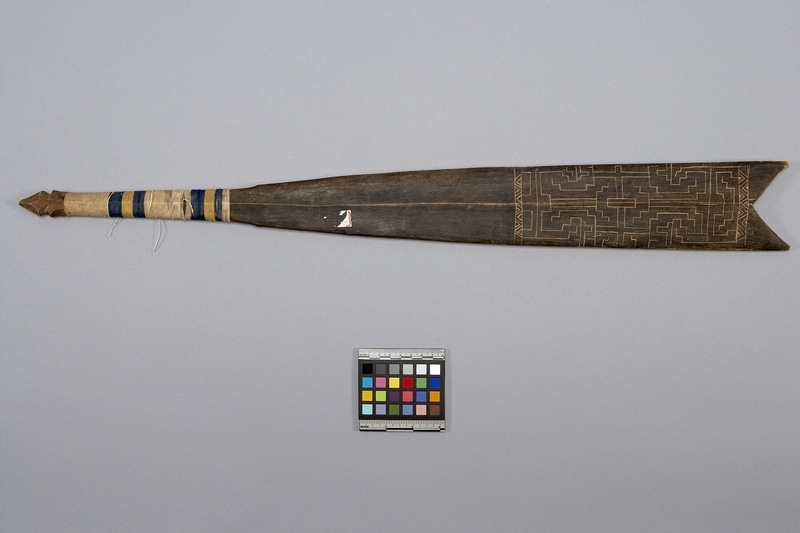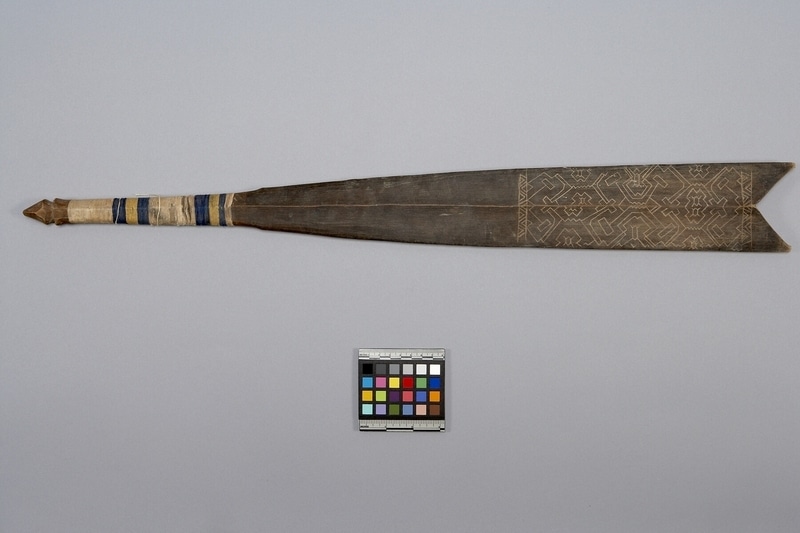Club Item Number: Se152 from the MOA: University of British Columbia


Description
Slim wooden club tapering from the notched head to the grip. In section, the blade is a very flat diamond, with slightly concave faces and a ridge at the centre on both sides. Handle is a flattened hexagonal shape, wound with alternating tan, blue, and yellow thread. Extremely small ridges at top of grip. Handle ends in a widened pommel with a pointed end. Blade has rough rectilinear patterns incised on each side (different) in mirror image around the central ridge. One side is typically parallel and perpendicular to the major axis of the blade; the other side is in diagonals to that axis. Overall dark brown; possibly a resin, oil, or other stain has been used. Probably chonta palm wood. Different geometric design on each side.
History Of Use
Use of the macana has been noted for some time in the region; it is perhaps a traditional weapon from pre-European contact, but archaeologically unstable medium prevents confirmation. It is used primarily in duels, particularly those over adultery, rather than warfare. Duels usually occur during male drinking parties. This example is very small: possibly a miniature toy or ornamental piece (for ritual?). The kené, or design is executed by women and taught by practice from one generation to the other. Kené motifs are revealed to specific people via icaruses, the songs shamans perform in ayahuasca ceremonies.
Cultural Context
weapon
Iconographic Meaning
The kené, or design, reproduced in wood, canvas, ceramics or human skin is an expression of the Shipibo’s worldview. It is inspired by the anaconda, which combines in its skin all possible patterns.
Narrative
The Shipibo live along the Ucayali River, a southern tributary of the Upper Amazon in Peru. In the 18th century they joined forces with traditional enemies to drive away missionaries and other foreigners. From the late 1800s to the 1920s they were enslaved by the caucheros, rubber entrepreneurs, and forced by violence to meet rubber production quotas. The caucheros were in turn employed by foreign companies, notably the infamous Anglo-Peruvian Amazon Rubber Co. Today, the c. 36,000 Shipibo are under pressure from the neighbouring Spanish-speaking mestizo population, commercial fishermen who have depleted their traditional waters of fish, turtles, and manatees, destroying their subsistence base. Money from tourism, primarily through women’s arts — textiles, jewellery and pottery — has become crucial to buy the food, medicine and access to Western education that will allow the Shipibo to survive in the modern world.
Item History
- Made in Peru
- Collected during 1973
- Owned by Tom A. Wylie before October 8, 1980
- Received from Museum of Anthropology Shop Volunteers (Funding source) and Tom A. Wylie (Seller) on October 8, 1980
What
Who
- Culture
- Shipibo
- Previous Owner
- Tom A. Wylie
- Received from
- Museum of Anthropology Shop Volunteers (Funding source) and Tom A. Wylie (Seller)
Where
- Holding Institution
- MOA: University of British Columbia
- Made in
- Peru
When
- Collection Date
- during 1973
- Ownership Date
- before October 8, 1980
- Acquisition Date
- on October 8, 1980
Other
- Condition
- fair
- Accession Number
- 0665/0029